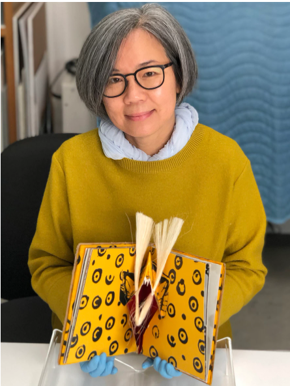The Hidden Secrets of Movable Books March 5, 2021

Tina Tan, conservator, works on paper.
Ámbar Past, et al, Bolom Chon, 2008, first edition, Taller Leñateros.
Johann Remmelin and Lucas Kilian, Catoptrum Microcosmicum: Suis Aere Incisis Visionibus Splendens, Cum Historia & Pinace, De Nouo Prodit. Sumptibus Iohannis Görlini, Imprimebat Balthasar Kühne, 1639, the MFAH, Hirsch Library, Museum purchase funded by Cecily E. Horton.
Johann Remmelin and Lucas Kilian, Catoptrum Microcosmicum: Suis Aere Incisis Visionibus Splendens, Cum Historia & Pinace, De Nouo Prodit. Sumptibus Iohannis Görlini, Imprimebat Balthasar Kühne, 1639, the MFAH, Hirsch Library, Museum purchase funded by Cecily E. Horton.
Tina Tan, conservator, works on paper
Thomas Malton and Brook Taylor, A Compleat Treatise on Perspective, in Theory and Practice ..., 1779, second edition, corrected and improved, printed for the author, sold by Messrs. Robson, Becket, Taylor, Dilly, and the author.
Thomas Malton and Brook Taylor, A Compleat Treatise on Perspective, in Theory and Practice ..., 1779, second edition, corrected and improved, printed for the author, sold by Messrs. Robson, Becket, Taylor, Dilly, and the author.
Ralph H. Segal and Theodore I. Segal, Bodyscope, 1935, Bodyscope Publications, Inc., New York City.
Since the 13th century, bookmakers and artists have looked for ways to bring life to the structure and form of the traditional book. The Hirsch Library exhibition Making the Movable Book: An Evolution of Paper Engineering investigates the multidimensional ways artists and publishers have played with techniques to expand the boundaries. The installation presents a variety of titles from the library’s collection that contain movable mechanisms such as pull tabs, flaps, and pop-ups.
Creating a Strategy
Imparting the thrill of opening a movable book and activating its operable mechanism to discover hidden secrets while the book is locked up in a case calls for a creative strategy. The display of a 1639 edition of Johann Remmelin’s Catoptrum Microcosmicum (Mirror of the Microcosm) is particularly challenging. This highly engineered anatomical book contains three plates of male and female figures, and each figure consists of overlapping flaps to illustrate the successive layers of the human body. More than 100 paper flaps of hand-cut and assembled copper-plate engravings allow readers to dig into the interior of the body. Some embedded parts can be removed for closer inspection.
The paper conservator made small, wedge-shaped inserts with Mylar polyester film and placed them between the flaps of the book to prop them open into 3D space. A few paper flaps from the book are used as built-in mounts to support neighboring layers, and with proper creasing of the paper, some flaps stand happily without external intervention. Employing the same polyester material, cube-shaped mounts were custom-made to showcase pop-up structures in Thomas Malton the Elder’s 1779 A Compleat Treatise on Perspective.
Activating a Dancing Tiger
A different strategy is used to activate the dancing tiger in Bolom Chon, a delightful pop-up book published in 2007 by Taller Leñateros, a collective of contemporary Tzotzil Mayan artists in Chiapas, Mexico. With a little help from polyethylene straps and neodymium magnets, the dancing tiger is now smiling widely at the Hirsch Library with its agave fiber whiskers and tongue turned up and sticking out.
Seeing for Yourself
Making the Movable Book: An Evolution of Paper Engineering is on view in the Hirsch Library reading room through March 20. To learn more, visit the virtual edition of Making the Movable Book.





